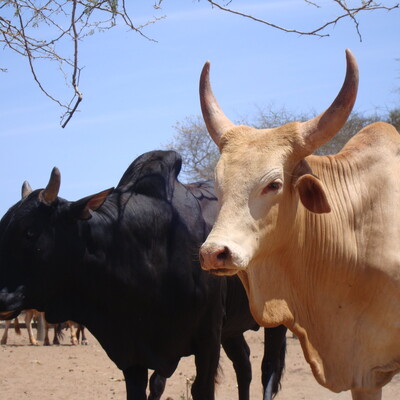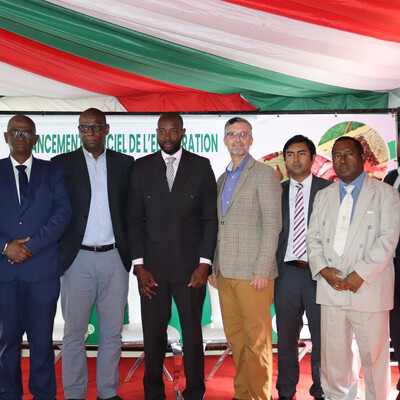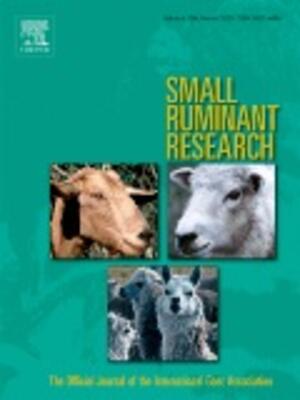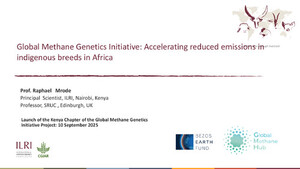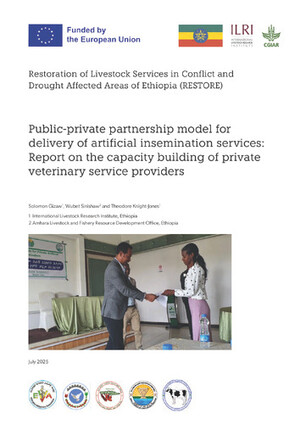
Ethiopia sets out the futures for its growing poultry, dairy and meat subsectors

ILRI senior livestock adviser Barry Shapiro (photo credit: ILRI).
A new livestock sector analysis from the Ethiopia’s Livestock State Ministry (LSM) and Ministry of Livestock and Fisheries (MoLF) and the International Livestock Research Institute (ILRI) was recently published. This work was funded by the Bill & Melinda Gates Foundation (BMGF) to help Ethiopia in its fact-based planning.
Lead author of the analysis, ILRI senior livestock advisor Barry Shapiro, had this to say about his team’s findings.
The results of the Ethiopia Livestock Sector Analysis clearly demonstrate that there are very attractive potential returns to investing in improving animal production in the country.
These potential returns, ranging from about 20 to 40% per year, signify that much higher investments in the sector by governments, development partners and the private sector are warranted.
That Ethiopia is ambitious to improve livelihoods in rural areas significantly makes increased investment in livestock essential. This is due not only to the high potential returns to investment but also to the many benefits livestock bring to the country’s food and nutritional security and the large numbers of livestock-keeping households in Ethiopia.
Livestock already are making significant contributions to Ethiopia’s national economic growth. The sector now makes up 40% of the country’s agricultural gross domestic product and 27% of its national GDP.
The Ethiopia Government has many development objectives for the sector, some of them that could be conflicting. For example, while ambitious to increase red meat exports (from beef, mutton and goat) to earn more foreign exchange, the government also wants to meet a rapidly growing domestic demand for meat. (The current deficit of meat on the local market already makes the price of Ethiopian beef two times that of the world market price.)
A way to create a ‘win-win’ in this area, as the livestock sector analysis shows, is to invest heavily in broiler and layer chicken production so that domestic chicken supplies increase rapidly and the prices of all meat in Ethiopia decline—allowing more red meat to be exported. To achieve this, a change in cooking and eating habits will be needed, requiring significant investments in advertising and dietary education to promote eating broiler meat and layer eggs rather than the traditional local ‘doro’ chicken and eggs.
Increasing chicken production with broilers and layers rather than increasing the numbers of cattle, sheep and goats could provide the additional benefits of increasing investment in, and employment of, women and youth while lowering the greenhouse gas emissions generated by the country’s livestock sector.
—Barry Shapiro, ILRI senior livestock economist
From the executive summary
To effectively launch and carry out its work, Ethiopia’s new Livestock State Ministry (LSM) requires a vision of what can and needs to be accomplished to develop the sector, built on a factual baseline and realistic targets and priorities, along with a realistic strategy and ‘road map’ or action plan—what the ministry calls a ‘livestock master plan’. This Ethiopia livestock sector analysis is a critical input into Ethiopia’s livestock master plan.
This report also seeks to inform other Ethiopian government policymakers involved in livestock development on the current status and future potential for poverty reduction and economic growth of the livestock sector. It is based on a quantitative analysis of the technical performance of the sector and its economic contribution to the household and national economy, using a set of tools from the Livestock Sector Investment Policy Toolkit (LSIPT). This toolkit was developed by a group of international agencies under the aegis of the Platform for the African Livestock Development & Sustainable Economic Growth (ALive) of the African Union-Interafrican Bureau for Animal Resources (AU-IBAR). The analysis is based on field surveys, literature and expert opinions, continuously validated through consistency tests.
Development of the Ethiopia livestock sector analysis
Using the most recently available data, from 2013, ILRI and the LSM employed the LSIPT2 to develop livestock herd and sector models and a baseline assessment of the current state of agricultural development in Ethiopia upon which to assess the potential long-term, 15–20 year, impact of proposed combined technology and policy interventions, referred to as the livestock sector analysis. The results of that analysis then formed the basis for the development of the Growth and Transformation Plan (GTP) II targets and the Ethiopian Livestock Master Plan 2015–2020. The master plan is a series of five-year development implementation plans or ‘roadmaps’, to be used to implement in the GTP II period and beyond.
Interventions in the Ethiopia Livestock Sector Analysis and the Ethiopia Livestock Master Plan were tested using sector model measures of the Ethiopian Government’s livestock development and policy objectives for GTP I and II. The GTP objectives employed to assess the investment interventions of the Ethiopia Livestock Master Plan were to:
- reduce poverty
- achieve food and nutritional security
- contribute to economic growth (GDP) and agro-industry development
- contribute to exports and foreign exchange earnings and
- contribute to climate resilience
Using indicators for the above objectives, three key livestock commodity value chains—poultry, for chicken meat and eggs; crossbred cattle, mainly for milk; and ruminant livestock red meat and milk (from indigenous cattle, sheep, goats and camels)—were identified in the livestock sector analysis as those sub-sectors with most potential to contribute most significantly to the long-run development of Ethiopia’s livestock sector. In each of these commodity value chains, the analysis focuses on both smallholder family and specialized commercial production systems. These three value chains and six sub-value chains are found in one or more of the three major production typology zones of Ethiopia, officially categorized by the Ethiopia Ministry of Agriculture as: lowland grazing, including both pastoral and agropastoral systems; mixed crop-and-livestock production systems in rainfall-deficient highlands; and mixed crop-and-livestock production systems in rainfall-sufficient highlands.
A summary of the findings of the report shows the following
- The national herd, consisting of about 55.2 million cattle, 29 million sheep, 29 million goats, 4.5 million camels and close to 50 million poultry, annually produces some 1,128 metric tonnes (MT) of meat, 174 million eggs and 5.2 billion litres of milk. This national herd also provides about 68 million MT of organic fertilizer and almost 617 million days’ worth of animal traction. The technical parameters, in particular for mortalities of young stock, are poor compared to data from similar production systems elsewhere in Africa.
- For the purposes of this study, a typology for the different livestock systems was developed, consisting at the first level of (a) the predominantly grazing or grassland systems of Ethiopia’s lowlands and (b) the rainfall-deficient and (c) the rainfall-sufficient mixed farming systems at higher elevations. Most of Ethiopia’s cattle are found in the mixed systems, sheep are about equally distributed between highland mixed and lowland grassland systems, and goats and camels are predominantly found in the lowlands.
- Ethiopia’s national livestock herd provides all or part of the livelihoods of more than 11.3 million rural households, of which 27–35% of the highland livestock keepers and a larger proportion of the lowland herders live below the national poverty line, which, based on a 2010/11 household survey conducted by Ethiopia’s Central Statistic Agency, is 3,781 Ethiopian birr (ETB) per adult equivalent per year, or about ETB20, or USD0.50, per person per day.
- The highest proportion of poor livestock-keepers in Ethiopia is in the lowland grassland systems and the lowest proportion (27%) is in the rainfall-sufficient mixed highland systems. The highest absolute numbers of poor people are found in the rainfall-deficient mixed highland systems. A more in-depth analysis shows that (a) cattle is the dominant species for 70–90% of the livestock holding households; (b) livestock’s contribution to total household income is higher in poorer households in the highlands than in other zones; (c) village poultry across all agro-ecological zones and goats in the lowland grasslands have the highest annual income per unit of tropical livestock units. A focus on reducing poverty would give priority to cattle, goats and village poultry in all systems, especially in the lowland grasslands and the moisture-sufficient mixed crop-livestock highland systems.
- The direct contribution of livestock to Ethiopia’s gross domestic product (GDP) is estimated by LSIPT at ETB150.7 billion per year, which comprises 17% of Ethiopia’s GDP and 39% of its agricultural GDP. If livestock processing and marketing (estimated at ETB35.6 billion a year) is taken into account, this proportion rises to about 21% of national GDP and 49% of agricultural GDP. If the indirect contribution of livestock organic fertilizer and traction (estimated at ETB37.8 billion a year) is taken into account, the contribution livestock make to Ethiopia’s GDP rises to 25.3%.
- The direct contributions livestock herds and farms make to Ethiopia’s GDP are from milk (34%) and meat (32%), with the rest generated by other livestock services or products. In terms of livestock systems, these livestock contributions to Ethiopia’s GDP are about equally distributed over the countries’ three major agro-ecological zones, while the contributions of the specialized systems of urban dairy for milk and feedlots for red meat remain incipient.
- The demand for meat and milk in Ethiopia is currently met mainly from domestic production. But an exploding demand for meat and milk due to a growing population (estimated to reach 127 million people in 15 years) and rising per capita income, are expected to cause deficits of about 1.3 million MT (53%) of meat and 3,185 million litres (29%) of milk by 2028. Per capita meat consumption by that year should be about 24.5 kg/year, which is about on par with other countries at a similar stage of development. Meeting these meat and milk gaps will require substantial investments in the Ethiopian livestock sector.
- The livestock sector analysis projects that if the proposed investment interventions are put in place and successful, the country will have an annual 20% surplus of about 2 billion litres of milk by the year 2028. The analysis indicates that the projected milk surplus will be realized through investments in better dairy genetics, feed and health services for both traditional dairy farms and commercial-scale specialized dairy production units.
- Closing the projected gap in meeting meat consumption demands will require vast increases in both traditional backyard family poultry enterprises and commercial-scale poultry broiler and layer units.
- Investments in improving poultry production systems can also generate an overall surplus of meat production over projected consumption requirements by 2028. The surplus in 2028 is projected to be about 8%, or 181,000 MT of meat per year.
- Poor market access and lack of infrastructure limit the production of value-added livestock products (just 31.5% of farm/herd-level livestock products are ‘value added’ versus 100% or more of livestock products in member countries of the Organization for Economic Co-operation and Development. Furthermore, relatively short supply channels lead to moderate post-harvest losses in livestock-derived foods. While the livestock sector analysis estimates Ethiopia’s post-harvest milk losses at just 3.4 %, post-harvest losses of all types of meat range from 11 to 24%.
- Price analysis along the meat and dairy value chains shows that the average price increases and gross margins are quite high for most of the actors in the chains, especially for processors and food service providers who are adding value through processing or transformation of livestock-derived foods. This implies that these livestock value chain actors are operating in a lucrative business environment with few competitors. Greater and easier entry into these livestock markets, however, will require policies improving access to land and credit.
- While improvements in animal health, genetics, feeding and management improve livestock performance substantially, the projected gap in Ethiopian milk supplies by 2028 remains large, implying that a broader effort will be required to close the milk gap.
- Inadequate feed supplies, of grass and fodder in particular, will most likely be the main physical constraint to further expansion of Ethiopia’s livestock population. The LSIPT feed resources module estimates that sufficient grazing and fodder in an average year is available only for the lower grasslands and is available for the rainfall-deficit mixed crop-livestock highland systems only in a ‘good year’. Furthermore, by 2028 all of Ethiopia’s agroecological zones except the lower grasslands are projected to be dramatically deficient in these livestock feeds if the current increases of the country’s stock numbers continue.
- The animal disease constraint analysis points to the following diseases that should be major priorities for Ethiopia: (1) foot-and-mouth disease (FMD), (2) peste des petits ruminants (PPR, also known as ‘ovine rinderpest’ and ‘goat plague’), (3) tsetse-transmitted trypanosomosis (often abbreviated to ‘tryps’), (4) external parasites (called ‘ekek’, the Amharic word meaning ‘itch’), (5) sheep and goat pox and (6) contagious bovine pleuropneumonia (CBPP).
- Clear policies exist regarding the roles of the private and public sectors in livestock development, in particular in the provision of livestock services and inputs, but implementation is limited. Unfavourable regulatory and fiscal frameworks for allocating land and producing livestock feed, respectively, lead to a reluctance of private operators to invest in livestock development and are constraints to further equitable growth of the sector.
Strategic policy recommendations
- Priority is given to increasing the productivity or production per animal by addressing feed deficits and improving animal health and genetics. Among the key policy and investment actions to support increased productivity are: (1) enhancement of veterinary coverage through private-public partnerships to reduce livestock deaths and disease, (2) promotion of fodder production through the revision of land allocation rules and (3) accelerated introduction of improved genetics once feed production and health services are in place.
- Convergence of Ethiopia’s livestock sector analysis with its climate-resilient green economy and livestock investment plan: The resilience of the livestock sector to climate change could be improved and other national development objectives could be met by dramatically decreasing the greenhouse gases (GHG) generated in chicken production and consumption and by regulating cattle and other higher GHG emitters through greater off-take. Furthermore, additional investments should be made to increase the productivity of all livestock species considered priorities in the livestock sector analysis.
- Since an increase in the numbers of ruminant animals in the national herd is still expected to occur, the environmental consequences of this increase will need to be closely monitored since it threatens resource degradation from overgrazing. Policies introducing disincentives to increasing herd sizes, especially of low-productivity indigenous breeds, rather than improving productivity and/or switching to lower emitting animals (such as a tax per animal head) could be considered.
- Success in modernizing the poultry subsector will require policy interventions that help ensure that sufficient land is allocated and put into poultry feed production (especially maize and soybean) and that the private sector is encouraged to invest in poultry agribusinesses—especially day-old chick production and meat and egg processing.
- If poultry can substitute for red meat, then red meat can be exported to meet the government’s export goals to earn foreign exchange. However, tastes and preferences for local chicken, or ‘doro’, would have to be changed through promotion of exotic chicken meat and changes in cuisine.
- While in the long run, government policy would have to focus on the threatening projected domestic supply gap, promotion of export beef can be the ‘pull’ factor for general improvement later. A dual policy of seeking broad animal health coverage for poor smallholders while increasing exports and gaining access to attractive and remunerative markets in the region is therefore needed. This will also require a major increase in investments to enhance the quality and safety of the animal-source food products.
- There is need for balanced policies to encourage investment in animal production and meat processing to meet rapidly increasing domestic demand for meat as well as for export to prevent the exploding domestic demand from constraining export potential.
- Special incentives are needed (review of the business climate, tax facilities, training) to promote more value adding through processing and product transformation combined with clearer roles of the public and private sectors.
This, in turn leads to the following scenarios that have been tested for their economic feasibility. The agents of change will be technology interventions supported by policy adjustments.
- Policy measures rationalizing public- and private-sector roles in the provision of veterinary services combined with investments in animal health, feeding and management to reduce young stock mortality in all livestock systems.
- Dairy breeding improvement interventions, combining artificial insemination (AI) using exotic semen with oestrus hormone synchronization in the rainfall-sufficient mixed highland systems. The investment scenario results of the livestock sector analysis show the rate of return on investment in AI and hormone synchronization is not attractive in the rainfall-deficient mixed highland systems.
- To reduce poverty, transform Ethiopia’s traditional backyard family poultry systems through massive importation and dissemination of improved semi-scavenging poultry breeds by the private sector and, where the private sector is reluctant to enter on its own, through public-private partnerships, with private animal health services providing critical vaccines and government extension services promoting better poultry feeding.
- In addition, mass introduction of ‘improved semi-scavenging crossbreeds’ or ‘improved indigenous semi-scavenging chickens’ to create a market-oriented improved family poultry system which produces far more eggs and meat when provided with supplemental feeding and adequate health services.
- Revision of the land allocation policy framework to enable investments in fodder production and trade.
- Promotion of feed efficiency through removal of the value-added tax (15%) and duty (53%) on feed mill ingredients and introduction of quality control measures.
- Enhanced livestock exports to more remunerative markets through introduction of a practical and affordable system of animal identification and traceability.
The livestock sector analysis shows attractive economic returns for these investments but, as stated, the resulting productivity increases have limited impact on closing demand-supply gaps. Closing the gap between Ethiopia’s meat supply and demand by 2028 requires both that the national herd grows and that additional productivity-increasing interventions are put in place. Achieving the required increases in milk productivity and milk production requires substantial genetic improvement of the national herd and concomitant improvements in animal feed, health and management practices.
Recommended follow-up actions
- Prepare action plans and start implementing the high-priority policies and investments identified in this report, i.e. in animal health, fodder and value adding.
- Use the LSIPT database and the Ethiopian ministry and ILRI staff trained in its use to further refine the options already tested and to assess new potentially attractive investments.
- Establish in the Ethiopian Ministry of Livestock and Fisheries, in coordination with other relevant agencies, a livestock policy support unit with the staff, hardware, data and budget needed to support the ministry in policy formulation using the LSIPT database and other tools.
- Ensure that in all future surveys priority is given to closing the data gaps identified during this exercise, in particular for the lower grasslands, small ruminant systems and value chains.
Read the whole report: Barry Shapiro (ILRI), Getachew Gebru (Managing Risk for Improved Livelihoods-Ethiopia), Solomon Desta (Managing Risk for Improved Livelihoods-Ethiopia), Asfaw Negassa (ILRI), Kidus Nigussie (Ethiopia Ministry of Agriculture), Gezahegn Aboset (Ethiopia Ministry of Agriculture) and Henok Mechale (Ethiopian Meat and Dairy Industry Development Institute of the Ethiopia Ministry of Industry), Oct 2017, Ethiopia livestock sector analysis: A 15-year livestock sector strategy, ILRI Project Report, Nairobi, Kenya: International Livestock Research Institute (ILRI).






